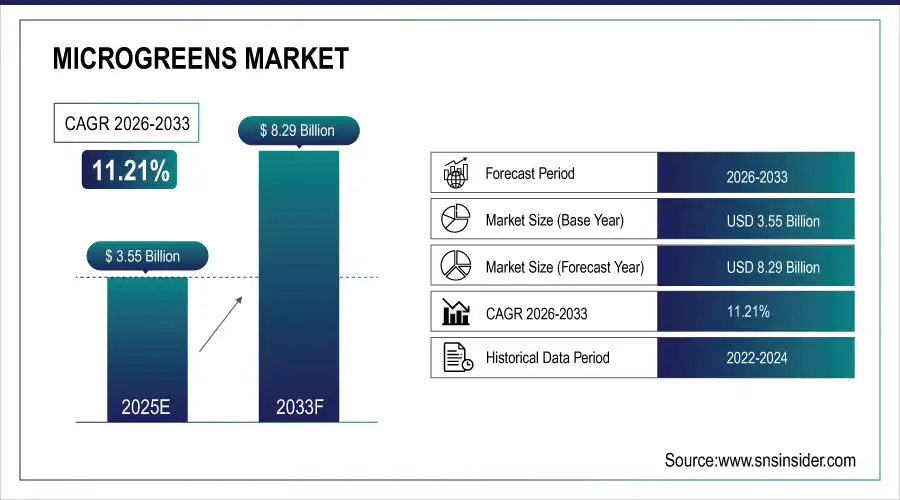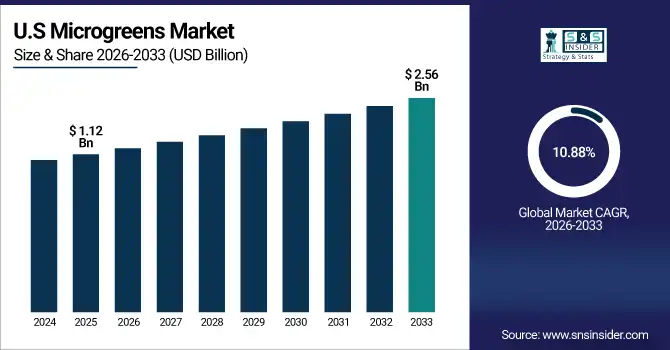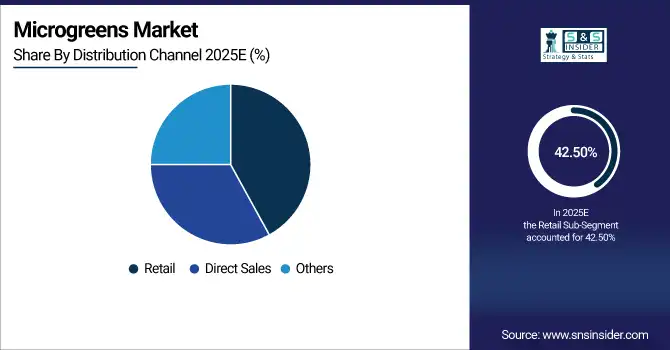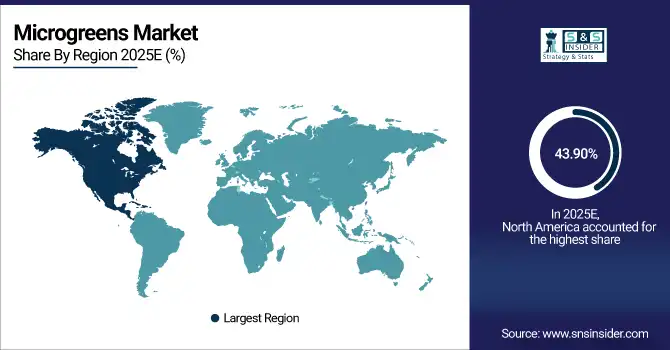Microgreens Market Report Scope & Overview:
The Microgreens Market Size was valued at USD 3.55 Billion in 2025E and is expected to reach USD 8.29 Billion by 2033 and grow at a CAGR of 11.21% over the forecast period 2026-2033.
The Microgreens Market analysis, due to the rising health consciousness among consumers globally. Vitamins, minerals and antioxidants microgreens are abundant sources of vitamins, antioxidants and minerals. The market is gaining traction owing to rising demand from urban households, health-conscious restaurants and gourmet food joints. According to study, Health-focused restaurants and gourmet establishments contribute to nearly 30–35% of microgreens demand globally.
Market Size and Forecast:
-
Market Size in 2025: USD 3.55 Billion
-
Market Size by 2033: USD 8.29 Billion
-
CAGR: 11.21% from 2026 to 2033
-
Base Year: 2025
-
Forecast Period: 2026–2033
-
Historical Data: 2022–2024

To Get more information On Microgreens Market - Request Free Sample Report
Microgreens Market Trends
-
Rising consumer health awareness fuels demand for nutrient-dense microgreens worldwide.
-
Urban households increasingly include microgreens in daily meals for better nutrition.
-
Health-focused restaurants and gourmet outlets expand microgreens usage on menus globally.
-
E-commerce platforms boost subscription-based microgreens delivery services across metropolitan areas.
-
Direct-to-consumer channels reduce supply chain challenges, ensuring fresher microgreens availability.
-
Growing preference for organic and locally sourced produce accelerates market adoption.
The U.S. Microgreens Market size was USD 1.12 Billion in 2025E and is expected to reach USD 2.56 Billion by 2033, growing at a CAGR of 10.88% over the forecast period of 2026-2033, driven by urban population demand, premium restaurant usage, and increasing subscription-based home delivery services. Adoption of hydroponic and vertical farming techniques ensures year-round supply, while e-commerce platforms enhance accessibility, supporting sustained market expansion across the country.

Microgreens Market Growth Drivers:
-
Rising Health Consciousness Boosts Microgreens Demand Globally and Rapidly
Microgreens Market growth is driven by Increasing demand for health and nutrition all over the world. Microgreens have a high nutrient content and can contain considerably more vitamins, antioxidants, and minerals than their mature counterparts. This makes them particularly attractive for health-conscious consumers, urban households and top end restaurants who are looking for fresh and healthy ingredients. Furthermore, the trend towards organic and locally-sourced food products is driving adoption even higher. With more consumers seeking food and beverage that bolsters the immune system with antioxidant rich ingredients, demand for microgreens into retail, direct-to-consumer subscriptions and foodservice outlets is growing.
Microgreens contain up to 40 times higher concentrations of vitamins and antioxidants than their mature vegetable counterparts, making them a potent source of nutrition per gram.
Microgreens Market Restraints:
-
High Production Costs and Perishability Challenge Microgreens Market Expansion
Despite growing demand, microgreens face a significant restraint due to food source still have challenges owning to expensive production costs and the perishability of this kind of vegetable. They must be grown in controlled conditions usually indoor farms, for example, vertical farming systems which carry a much higher initial investment to your infrastructure, lighting and hydroponic outlets. Additionally, microgreens have a limited shelf life that renders storage, transportation, and retail handling difficult. These contribute to higher running costs and restrict broad based uptake in markets where technology farming solutions are not common.
Microgreens Market Opportunities:
-
E-Commerce and Direct-to-Consumer Channels Unlock New Growth Opportunities
The fast expansion of online business and home delivery companies is a great opportunity for the microgreens market. There’s an ever-growing demand from consumers for subscription microgreens delivery so that they can receive fresh produce direct to their front door. Producers can bypass conventional supply chain constraints, minimize post-harvest losses and connect with a wider pool of customers. Additionally, demand for microgreens is likely to increase with the rising popularity of online grocery shopping and health-oriented meal kits which are particularly popular in urban or semi-urban areas where time and freshness are key factors.
Health-focused meal kit services incorporating microgreens have grown by 18% year-on-year in subscription volumes.
Microgreens Market Segmentation Analysis:
-
By Product Type: In 2025, Broccoli led the market with a share of 28.80%, while Arugula is the fastest-growing segment with a CAGR of 11.80%.
-
By Farming Method: In 2025, Indoor led the market with a share of 59.40%, while Vertical Farming is the fastest-growing segment with a CAGR of 20.20%.
-
By Growth Medium: In 2025, Peat Moss led the market with a share of 34.20%, while Coconut Coir is the fastest-growing segment with a CAGR of 15.90%.
-
By Distribution Channel: In 2025, Retail led the market with a share of 42.50%, while Direct Sales is the fastest-growing segment with a CAGR of 13.20%.
By Product Type, Broccoli Lead Market and Arugula Fastest Growth
The Broccoli leads the market in 2025, due to its high in nutritional content, easily available, and preferred by consumers who looking for vitamin-rich greens. GreenWave Organics microgreens are being used in salads, sandwiches and gourmet dishes driving demand through the retail, foodservice and direct-to-consumer channels. Meanwhile, Arugula is the fastest expanding category driven by increased demand among health-conscious consumers and chefs looking for a distinctive flavor and peppery finish to premium dishes. Growing e-commerce, subscription services, and urban farming solutions are also promoting the market of these microgreens worldwide.
By Farming Method, Indoor Lead Market and Vertical Farming Fastest Growth
The Indoor lead the market in 2025, owning to its controlled environment, better yield per square meter and production all over the year. Indoor farms make it possible to control light, temperature and nutrients to fine-tune product quality, reducing the risk of contamination they appeal more to urban households, high-end dining establishments and retail channels. Meanwhile, Vertical Farming is the most expeditious growing segment on account of technological advancements, occupy less space and should be developed and adopted by more metropolitan, because they have less available arable land. The combination of IoT, hydroponics and automation has also added to the increasing prominence of vertical growing around the world.
By Growth Medium, Peat Moss Lead Market and Coconut Coir Fastest Growth
The Peat Moss leads the market in 2025, due to its high-water retention, air-holding capacity and applicability to both indoor & traditional farming. Its healthy root development capability results in higher yields and uniform quality, providing a better option for commercial growers and urban farmers. Meanwhile, Coconut Coir has emerged as the fastest-growing segment on account of its sustainability, renewable sourcing and better water holding capacity than conventional media. Growing application of the coconut coir in hydroponic and vertical farming systems globally is expected to fuel market growth with higher consumption to support eco-friendly farming solutions.
By Distribution Channel, Retail Lead Market and Direct Sales Fastest Growth
The Retail leads the market in 2025, due to the widespread presence of supermarkets, hypermarkets, and other specialty stores provide easy access and visibility of fresh microgreens, thereby resulting in high demand for these outlets. The two areas of distribution are volume-based retail, urban households and health seekers who are interested in convenient and ready-to-use produce. Meanwhile, Direct Sales is the fastest growing segment by mode of sale with a surge being driven by greater comfort with e-commerce, home delivery demand, along with freshness brought right to one’s doorstep. Direct to consumer microgreens sales are being driven worldwide by the expansion of digital platforms, meal-kit integrations and urban consumer demand for quality produce.

Microgreens Market Regional Analysis:
North America Microgreens Market Insights:
The North America dominated the Microgreens Market in 2025E, with over 43.90% revenue share, driven by consumers are seeking out healthy and nutritional food, increase in demand for organic Nutrient-dense vegetables leaves and higher disposable income. Microgreens are always used for daily consumption and gourmet cooking in urban areas. Expansion is fueled by a number of factors, including the rise of e-commerce platforms and direct-to-consumer subscription services that make fresh produce more accessible, and sustainability efforts and increased awareness around environmentally friendly farming practices driving further growth.

Get Customized Report as per Your Business Requirement - Enquiry Now
U.S. Microgreens Market Insights
the Microgreens Market is led by U.S. and Canada on account of high health-conscious consumers, growing preference towards organic and nutrient rich foods and increasing use of novel indoor and vertical farming technologies across the region. Mature retail, foodservice, and direct-to-consumer platforms also help drive deep market penetration and sustained growth in these areas.
Asia Pacific Microgreens Market Insights:
The Asia-Pacific region is expected to have the fastest-growing CAGR 12.64%, owing to increasing health consciousness, escalating inclination for nutrition rich diet and rapid urbanization. Demand for fresh, organic and locally raised produces, in retail, food service and subscription-based markets. The growing e-commerce and on-demand delivery ecosystem is facilitating the convenience of access while burgeoning concerns towards sustainable and eco-friendly farming is leading to market expansion. Fast urban life and on-the-go consumer habits also drive adoption of microgreens in this region.
China and India Microgreens Market Insights
The China and India are the fastest growing market as due to rapid urbanization, increasing disposable income level and increase in the health consciousness among consumer. The adoption of contemporary indoors and vertical gardening, the rise in e-commerce channels and direct consumer purchases are driving growth in the availability and uptake of microgreens.
Europe Microgreens Market Insights
Microgreens Market in Europe has captured a substantial market share owing to growing health-conscious consumers that are inclining towards fresh and nutrient enriched consumable goods. Increasing interest in organics and locally sourced products has helped to fuel demand from retail, foodservice, and through direct channels. Cutting-edge indoor and vertical farming technologies, meanwhile, allow year-round harvesting and larger harvests for both commercial growers and city farms. Boost in E-commerce and the rise of subscription-based delivery services support convenience and accessibility, whereas market adoption is driven by sustainability programs and eco-friendly farming practices.
Germany and U.K. Microgreens Market Insights
The UK and Germany are increasingly expanding Microgreens Market on the account of growing consumer preferences for health-based foods, growing demand for organic and local products, as well increasing use of advanced indoor and vertical farming technology. Ease of access is even more improved by the advent of e-commerce platforms and subscription services, which has spurred increased consumption rates and market growth in these areas.
Latin America (LATAM) and Middle East & Africa (MEA) Microgreens Market Insights
Latin America, and Middle East & Africa microgreens market is growing progressively due to elevation in consumer awareness regarding healthy food products which provide high nutritional value, and upsurge in demand from retail and foodservice industry. Increasing population in cities, disposable income levels and change in consumer preference towards organic, locally grown food is driving market adoption. Moreover, the rise of e-commerce and direct-to-consumer delivery services increase accessibility, and efforts towards sustainability and environmentally friendly farming practices add a second layer of incentives to purchase – setting up both regions for future market growth.
Microgreens Market Competitive Landscape
GoodLeaf Farms exemplifies the growing adoption of indoor vertical farming in the microgreens market. By leveraging controlled-environment technology and hydroponic systems, the company ensures year-round, high-quality microgreens production. Their expansion into urban centers demonstrates increasing consumer demand for fresh, nutrient-rich, and locally grown produce, highlighting a shift toward sustainable and technology-driven agriculture in North America.
-
In August 2025, GoodLeaf Farms opened a new indoor vertical farm in Montreal, enhancing year-round microgreens production. This facility uses advanced hydroponic systems and controlled environment technology to optimize growth and improve yield efficiency.
Bowery Farming’s innovations in automated vertical farming showcased the potential of high-tech cultivation methods for microgreens. Although it ceased operations due to financial constraints, Bowery highlighted the scalability and efficiency opportunities in urban microgreens production. Their legacy underlines the growing interest in sustainable, fresh, and locally sourced greens, and the challenges startups face in funding and market penetration.
-
In November 2024, Bowery Farming announced the cessation of operations due to financial challenges and inability to secure additional funding. Despite innovative vertical farming solutions and strong sustainability initiatives, the company faced operational cost pressures and declining venture capital support, which ultimately led to its closure.
Plenty Unlimited has driven the microgreens market through large-scale indoor vertical farming solutions, combining sustainability and productivity. Their operations in controlled environments allow high yields of nutrient-dense microgreens, reflecting increasing demand from health-conscious consumers. Despite financial setbacks, plenty demonstrated the market’s potential for technologically advanced, scalable, and year-round microgreens cultivation in North America and beyond.
-
In September 2024, Plenty Unlimited opened the world's first large-scale indoor vertical strawberry farm in Richmond, Virginia. This facility showcased Plenty's expertise in large-scale controlled-environment agriculture and aimed to combine sustainability with high-yield production.
Microgreens Market Key Players:
Some of the Microgreens Market Companies are:
-
AeroFarms
-
Bowery Farming
-
Plenty Unlimited
-
Gotham Greens
-
GoodLeaf Farms
-
Fresh Origins
-
Farmbox Greens
-
Living Earth Farm
-
Chef’s Garden
-
Teshuva Agricultural Projects Ltd. (2BFresh)
-
Madar Farms
-
Metro Microgreens
-
Superior Fresh
-
Farm.One
-
Greeneration
-
Ibiza Microgreens
-
Wesh Grow
-
Enparalelo
-
Green Monkey Farms
-
Krop AI
| Report Attributes | Details |
|---|---|
| Market Size in 2025E | USD 3.55 Billion |
| Market Size by 2033 | USD 8.29 Billion |
| CAGR | CAGR of 11.21% From 2026 to 2033 |
| Base Year | 2025E |
| Forecast Period | 2026-2033 |
| Historical Data | 2022-2024 |
| Report Scope & Coverage | Market Size, Segments Analysis, Competitive Landscape, Regional Analysis, DROC & SWOT Analysis, Forecast Outlook |
| Key Segments | •By Product Type (Broccoli, Radish, Pea Shoots, Basil, Cabbage, Arugula, Others) •By Farming Method (Indoor Farming, Conventional Farming, Vertical Farming, Others) •By Growth Medium (Peat Moss, Soil, Coconut Coir, Tissue Paper, Other Growth Mediums) •By Distribution Channel (Retail, Direct Sales, Others) |
| Regional Analysis/Coverage | North America (US, Canada), Europe (Germany, UK, France, Italy, Spain, Russia, Poland, Rest of Europe), Asia Pacific (China, India, Japan, South Korea, Australia, ASEAN Countries, Rest of Asia Pacific), Middle East & Africa (UAE, Saudi Arabia, Qatar, South Africa, Rest of Middle East & Africa), Latin America (Brazil, Argentina, Mexico, Colombia, Rest of Latin America). |
| Company Profiles | AeroFarms, Bowery Farming, Plenty Unlimited, Gotham Greens, GoodLeaf Farms, Fresh Origins, Farmbox Greens (Charlie's Produce), Living Earth Farm, Chef’s Garden, Teshuva Agricultural Projects Ltd. (2BFresh), Madar Farms, Metro Microgreens, Superior Fresh, Farm.One, Greeneration, Ibiza Microgreens, Wesh Grow, Enparalelo, Green Monkey Farms, Krop AI, and Others. |

